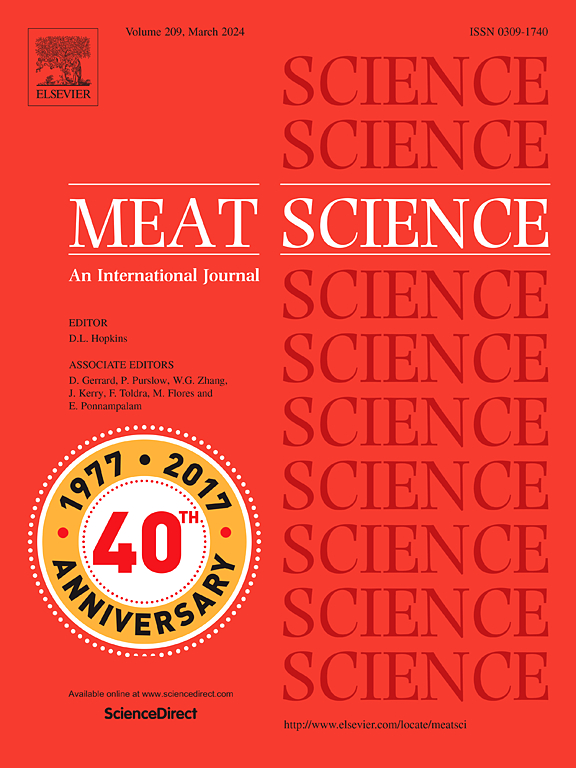Grape seed proanthocyanidin and sesbania gum: A novel strategy to enhance antioxidant capacity and reduce fat while maintaining the physicochemical, sensory, and processability of lamb sausage
IF 6.1
1区 农林科学
Q1 Agricultural and Biological Sciences
引用次数: 0
Abstract
This study explored the effects of grape seed proanthocyanidin (GSP) in synergy with sesbania gum (SG) on the antioxidant capacity, processability, moisture distribution, microstructure, and sensory properties of lamb sausages, to evaluate their synergistic advantages in improving sausage quality and SG's potential as a fat substitute. Findings revealed that GSP enhanced radical scavenging abilities (P < 0.05), while reducing thiobarbituric acid reactive substances (TBARS) and carbonyl content (P < 0.05). However, 0.10 % GSP supplementation decreased the degree of network structure polymerization. Adding 5 % SG reduced the fat content and energy value (P < 0.05), and promoted transitions in protein secondary structures from α-helix to β-sheet. Dynamic rheological behavior, scanning electron microscopy, and confocal laser scanning microscopy results showed that SG incorporation increased the storage modulus (G') and formed a denser network structure. This structural modification further improved the texture properties (hardness, gumminess, and chewiness) and reduced the shrinkage rate (P < 0.05). Low-field nuclear magnetic resonance analysis demonstrated that SG facilitated the conversion of free water to immobilized water and reduced the cooking loss rate (P < 0.05). Sensory evaluation pointed out that incorporating 5 % SG as a fat substitute in lamb sausages increased the flavor, juiciness, texture, and acceptability scores. Overall, the synergistic application of 0.10 % GSP and 5 % SG exhibited multiple benefits, namely enhancing antioxidant capacity, reducing fat content, and simultaneously improving the processing properties. These findings indicate that SG serves as a promising fat substitute that enables increased loading capacity of polyphenols without deteriorating the sausage quality.
葡萄籽原花青素和田菁胶:一种新的策略,以提高抗氧化能力和减少脂肪,同时保持羊肉香肠的理化,感官和加工性。
本研究探讨了葡萄籽原花青素(GSP)与田菁胶(SG)协同作用对羊肉香肠抗氧化能力、加工性能、水分分布、微观结构和感官性能的影响,以评价其在提高香肠品质方面的协同优势和田菁胶作为脂肪替代品的潜力。结果表明,GSP增强了自由基清除能力(P
本文章由计算机程序翻译,如有差异,请以英文原文为准。
求助全文
约1分钟内获得全文
求助全文
来源期刊

Meat Science
工程技术-食品科技
CiteScore
12.60
自引率
9.90%
发文量
282
审稿时长
60 days
期刊介绍:
The aim of Meat Science is to serve as a suitable platform for the dissemination of interdisciplinary and international knowledge on all factors influencing the properties of meat. While the journal primarily focuses on the flesh of mammals, contributions related to poultry will be considered if they enhance the overall understanding of the relationship between muscle nature and meat quality post mortem. Additionally, papers on large birds (e.g., emus, ostriches) as well as wild-captured mammals and crocodiles will be welcomed.
 求助内容:
求助内容: 应助结果提醒方式:
应助结果提醒方式:


